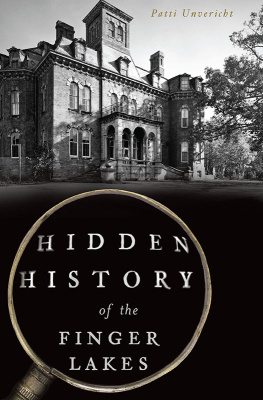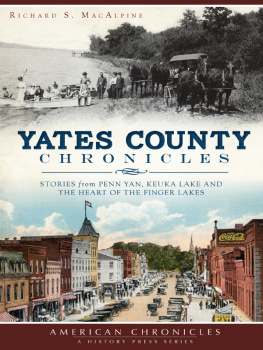


Published by The History Press
Charleston, SC
www.historypress.com
Copyright 2018 by Patricia Unvericht
All rights reserved
The Kirkbride main building was constructed in 1866 and demolished in 1980
First published 2018
e-book edition 2018
ISBN 978.1.43966.480.3
Library of Congress Control Number: 2018936076
print edition ISBN 978.1.46713.819.2
Notice: The information in this book is true and complete to the best of our knowledge. It is offered without guarantee on the part of the author or The History Press. The author and The History Press disclaim all liability in connection with the use of this book.
All rights reserved. No part of this book may be reproduced or transmitted in any form whatsoever without prior written permission from the publisher except in the case of brief quotations embodied in critical articles and reviews.
This book is dedicated to Steve, who gave me the inspiration and encouragement to keep going and live life with no regrets. And to my children, Liesl and Karl, who are my co-pilots on many adventures.
CONTENTS
ANDOVER SANITARIUM
Take a drive south on Route 21 through the rolling hills of Allegany County. The countryside is beautiful any time of the year, but during the autumn months, it puts on its best show. The air is crisp and clean as the sinking sun shines through amber leaves that glow as if they have been set on fire. As you crest the hill just north of the town of Andover, a breathtaking sight hits you. Pure-white church steeples peek through the fall foliage, welcoming visitors to their sleepy little town. With a history that spans over two centuries, Andover was once very much alive.
Who the first settler was in Andover is up for debate. Two men claimed the right to be called founder. Nathaniel Dike came to the area first, in 1795, but in 1807, Alpheus Baker was the first to settle in what is now the town center. Baker and Dike, as did other pioneers, blazed a trail west after the American Revolution so that others might follow them into what was the unknown wilderness. Towns like Andover sprouted up all over the place, and they flourished. For more than a century, Andover prospered. Businesses thrived, and small factories and processing plants supported the community. Although these small towns thrived in the nineteenth century, they all soon fell by the same sword, industrialization and modernization. What were once centers of commerce became bedroom communities, and their residents looked for employment in larger neighboring cities. Buildings and storefronts emptied and were abandoned, leaving behind shells of their former lives, memories of a more prosperous time. Each town had buildings that were more important to the towns history than others and citizens that embodied their spirit. The Victorian building affectionately known as the Bricklocated at 5 West Greenwood Streetand the couple who were its most prestigious owners played prominent roles in Andovers history.
The first burial ground in Andover was on John Goodwins lot, according to history.rays-place.com. Goodwins property was on Main Street, with the portion of his lot with the cemetery in what is now the backyard of the Brick. There were only a few interments in the cemetery, some of the very early deaths in the town prior to 1825. Those who were laid to rest there included the children of the town founders Alpheus Baker, James Woodruff, Luther Strong and Benjamin Brookins. It was also the final resting places of Mr. Lyons and Mrs. Lovell as well. The graves are still there, buried deep in the ground, but they have no stones to mark them. To those unaware of its existence, the cemetery is indiscernible.
The earliest known map of Andover with the West Greenwood property listed, along with its owners name, is from 1856. It was the location of Martindale Carriages, which was owned by William and Eliza Martindale. William died in 1868, followed by his wife four years later. After their deaths, no record shows what happened to the carriage shop. Devastating fires plagued towns during that time; wooden buildings tended to quickly go up in smoke, especially when fire was used to tame iron, like at a blacksmith shop or by a carriage maker. Its possible that was the fate of Martindales shop, because the lot was empty when the next owner bought it in 1876. The building that was then erected has an interesting and important history that is almost forgotten today.
While the Martindales were still alive, Dr. William Crandall resided on Elmwood Street. He came to Andover in 1858 and joined the practice of Dr. John Harmon. Dr. Harmon retired from the medical field to go into private banking and left his practice to Crandall. Sometime in 1876, Crandall acquired the property once owned by William and Eliza Martindale. He soon began building his grand home, or rather, the original structure Crandall had built went up in 1876. Before the good doctor could move in, the house was destroyed by a fire. All accounts and investigative reports of the fire point to the cause being incendiary in origin, meaning it was criminally set by an arsonist. Either it was set by someone with a personal vendetta against Dr. Crandall or by Crandall himself because of financial problems. There are rumors that support both theories. Regardless of the actual cause of the fire, Dr. Crandall rebuilt it as a beautiful, three-story brick building that stands there today, the Brick.

An 1856 map of Andover, originally published as part of a larger map of Allegany County by Gillette, Matthews & Company. Allegany County Historical Society.
Crandall was by far more educated than most small-town doctors of his time; he also was quite the humanitarian. It is said that he hardly ever charged the very poor for his services, and they received only the very best care. Dr. William W. Crandall died on March 19, 1899, in the nearby town of Wellsville. He is buried at the Alfred Rural Cemetery in Alfred, New York (alleganyhistory.org).
After Crandalls death, Daniel B. Spaulding purchased the Brick and turned it into his home. D.B. Spaulding was born in September 1820 in New Marlboro, Massachusetts. Early in his life, both he and his father were farmers. After Spaulding married Phebe Barton in 1850, they moved to New Hudson, New York, which is in the western portion of Allegany County, to find work in the lumber industry. He did whatever jobs necessary to provide for his family. It was not until 1867 that he and his family moved to Andover. By then, Spaulding was trying his hand as a businessman, dabbling in different ventures until he finally settled on running a drugstore. Daniel B. Spaulding died on August 30, 1906, and was laid to rest at the Valley Brook Cemetery in Andover.
Spaulding owned the Brick for only one year before the Egglestons bought it from him. They were the ones who gave the building life and were the most important of its owners. After they purchased the home, it reverted to the role of serving the community and those in need as a sanitarium.
Hattie Borden Eggleston was born on December 13, 1872, in Norwich, Connecticut. When she was a child, she was sickly. A disease or some other ailment left Hattie paralyzed. Her family was told that she would never walk again. Hattie did not like the prognosis that she was given by the doctors. It was only through strength and sheer determination that she was able to overcome her disabilities three years later. By nature, Hattie had a nurturing personality. It only made sense that she enrolled in a New York City nursing school and graduated first in her class and was the first to receive her white cap. After graduation, she met Vernon Eggleston. On December 8, 1897, they were united in marriage. Shortly after the wedding, they moved to Andover (189798), where Vernon became the preacher for the First Baptist Church.
Next page















